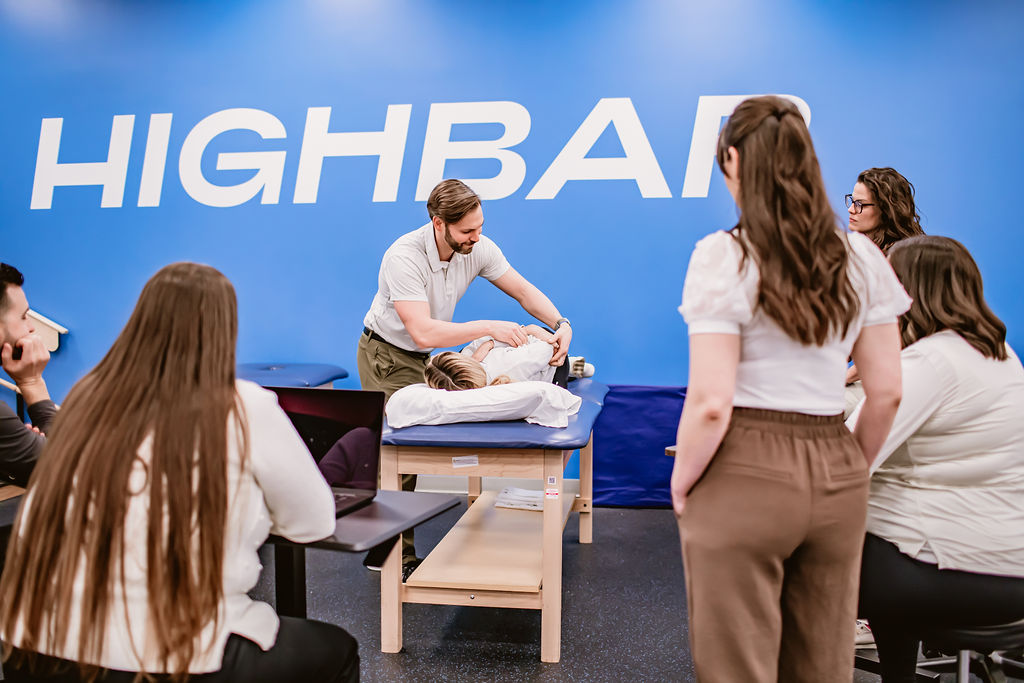Highbar Physical therapy & Health blog
Children can walk on their toes for any number of reasons. Sometimes they do it because it's fun and bouncy. Maybe they do it because the plush toy they're using is too far away. Maybe their muscles are tight if they have a condition like cerebral palsy. Or maybe their core is weak and it's actually easier to walk on their toes because of body mechanics at the ankle. Whatever the reason your child may choose to or have to walk on their toes, it is important to help them feel the floor with their whole foot and practice a more typical heel-to-toe gait pattern.
Why is it important to help improve your child’s toe walking?
Bones grow in response to stress and your child is growing so quickly! If only the front part of their foot is contacting the ground when walking, only those bones are being stressed. This means that they may grow more than the back part of the foot, which can make finding shoes that fit more difficult. This change in pressure through the foot during walking moves up the leg and impacts how muscles and other joints develop. Toe walkers sometimes have a harder time keeping up with friends on the playground and sometimes have pain. They may also be more inclined to trip and fall, so helping your child change how they walk can make a big difference in their life.
- Squatting and/or practicing sit-to-stand
Our favorite way to encourage repeated squatting is by having your child help to clean up their toys! With each toy they pick up from the floor, they've achieved another squat. If your child is younger or less independently mobile, you can start them sitting on your lap with their feet flat on the floor, and then help coax them to stand by shifting their weight forward at their hips until they are standing tall!
- Balancing on one leg
Balancing on one leg can be a challenge for children (and adults!) of all ages. Encouraging a flat-footed stance while balancing on one leg can make daily tasks more interesting. Try having your child brush their teeth while standing on one leg - this will be amusing to everyone involved. You can also turn it into a family competition of who can balance the longest?
- Climbing stairs
This activity has so many wonderful benefits. Repeated stair climbing encourages great strength in the legs while it improves your child's overall endurance. It also helps to provide dynamic stretching to the calf of the stance leg when a child walks down the stairs. Be sure to encourage your child to alternate which leg is leading so both sides get stretched and exercised!
- Scooter boards and standing scooters
Seated scooter boards allow for a child to really dig their heels into the ground and get good input and stress through those bones to help their brain learn about heel strike, commonly known by physical therapists as the first part of walking when your heel strikes the floor as you take a step. This is what our toe walkers are missing! So this activity can be really helpful for them to learn how to start taking the next step. Standing scooters are also great practice for learning balance, improving strength and endurance in the legs, and getting a good stretch - similar to when they climb the stairs!
- Core strengthening
Our favorite way to get your child engaged in core strengthening is through two different exercises - planks and bear walks. How do I get my child to do a plank? Great question. We like to have them walk over the top of a peanut ball or a small exercise ball and throw magnetic darts at a dartboard or complete a puzzle in this position. When they're doing a fun activity while planking, the plank seems less difficult. Bear walks are also a great way to not only get core engagement but to stretch out the backs of the legs. This can be fun to do outside, too, now that the weather is getting warmer to feel that grass on our palms.
Pediatric Physical Therapy in Rhode Island and Massachusetts
Want extra help? Schedule an appointment or request a phone consult with the pediatric physical therapists at Highbar. We are happy to help you through this process and help improve your child's walking.





